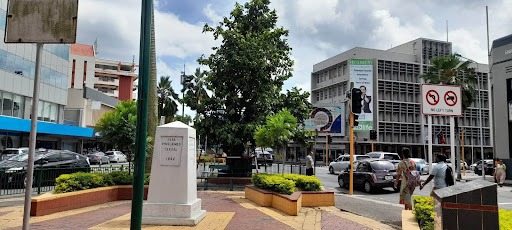Fiji’s Ivi Triangle: A symbol of history


If you have ever visited Fiji’s capital city lately, you’ll notice a damaged Tahitian chestnut tree (Ivi) supported upright by a scaffolding smack-dab in the middle of the city. The scaffolding is the latest attempt at salvaging the historic landmark that had resisted numerous cyclones in the last few years. Foreigners and those new to the city will question why this is so? For locals, it’s simple. This tree was and has been a symbol of colonial history.
Fiji’s history books detail numerous accounts of Tahitian chestnut trees scattered all throughout the capital city, but perhaps the most ‘iconic’ of them all, as it is often referred to, is the one on the corner of Renwick road and Thomson street. Known among locals by the name, ‘Ivi’ [e-vee], this tree holds more symbolism than actual history.
What does this mean? There is rarely any documentation of the actual Ivi tree located today in the Ivi triangle, the trees mentioned in early colonial history are distinct from this one but have been removed in the name of development.
Image by the Fiji Museum.
So first, let’s disclaim a few incorrect historical information inscribed on the monument by the tree. Early Wesleyan missionaries arrived in 1835, but it was two days earlier (12th October) than the date written on the plaque, which is the 14th. Two, the public land auction that took place in1880 as noted on the monument, took place under a different Ivi tree by the Nubukalou creek, supposedly about 250 metres east of the triangle. Suva was not proclaimed capital in 1882, European settlers declared Suva the capital in 1877. The official move was made in the year 1882 (although some would argue the year was 1881), and the settlement was finally declared a city in the early 1950’s. The only correct historical fact on the plaque is the ceding of Fiji to Britain on the 10th of October, 1874.
This does not denote the fact that the Ivi tree and the triangle have also played a role in Suva’s history, however less significant they may be. A wharf had been constructed presumably opposite what is known today as Pier street. The establishment of the Queen’s wharf brought in vendors trying to sell their produce. Thus, a small market had been established at the Ivi Triangle, and passengers waiting to board ships in the harbour would also convene at the triangle.
Local market by the Ivi tree at the triangle, circa 1892. Image by the Fiji Museum.
Ivi trees in Fiji seen throughout the capital are what’s left of the original shoreline and markers of an earlier colonial settlement. Why a plaque of incorrect facts? It is unclear, but perhaps the monument was an effort to memorialise a few of Fiji’s key historical moments besides one of the city’s few remaining Ivi trees.
The triangle and the park benches had always been a meeting point in the past, where many would convene for a rest before continuing about the capital city. The scene still continues to be the same today and will probably stay the same for a while.
If you and your friends ever want to rest on an unbearably hot day, find yourselves under the Fiji Ivi tree at the Ivi Triangle.
